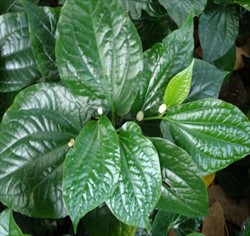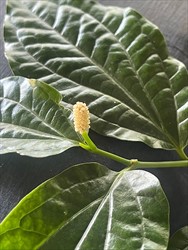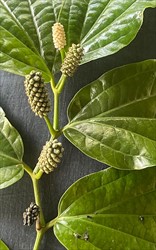Lolo pepper. It is also known as la lot, wild betel, Vietnamese pepper, and by local language names throughout Southeast Asia, Northern India and South China where is it used extensively in food preparation. Note, it is not the same as Piper betel, the leaves and flowers of which are chewed with betel nut, along with lime, in parts of Asia and Oceania (Papua New Guinea and Solomon Islands).
Pacific Pests, Pathogens, Weeds & Pesticides - Online edition
Pacific Pests, Pathogens, Weeds & Pesticides
Lolo pepper (547)
Piper sarmentosum. Previously, it was known as Piper lolot. It is a member of the Piperaceae.
Asia, Africa (Madagascar, Maritius, Reunion), North America (Hawaii), the Caribbean (Trinidad), Oceania. It is recorded from Australia (Christmas Island and three locations in Queensland - Thursday Island, Nelly Bay, Magnetic Island), Federated States of Micronesia (Pohnpei), Papua New Guinea. The native range is south China, Southeast Asia and northern Australia.
A shade-tolerant, low-growing (0.5-1 m), invasive perennial plant forming extensive ground covers, smothering agricultural crops and native vegetation in the forest understory (Photos 1&2).
Erect, rounded, smooth stems, brownish. Leaves alternate along the stems, simple, heart-shaped, 7-15 cm by 5-10 cm, dark green, glossy, with a leaf stalk up to 3 cm long (Photo 3). Creamy-white cylindrical flower clusters (spikes) arise from leaf axils. Female flower spikes up to 12 mm long (Photo 4). Some spikes are reported to contain both male and female sexes, whereas spikes of others are either male or female (on the same plant) with male spikes much smaller. The fruit is 'mulberry-like' with a single seed and a sweet taste when ripe (Photo 5).
Spread over short distances is by growth of underground rhizomes and by plant pieces that readily root. Over long distance, spread is associated with international trade in plants for cooking or medicinal purposes.
The impact of this this invasive weed is not well documented. Its effect on the natural diversity of forest understory is noted.
Used extensively in parts of Asia as a wrap for grilled meats to give a pungent spicy flavour. In Thailand, Malaysia and Laos it is used raw, sliced into salads. Some dishes include fish fillets wrapped in lolo pepper plus herbs and much else, wrapped again in banana leaves and steamed. It is also steamed as a vegetable or as a wrapper for snacks. The medical uses are varied. In India, Malaysia, Thailand, and China it is taken for coughs, asthma, fevers, rheumatism, diarrhea, aches (stomach and tooth) and traumatic injuries. Unrooted stem cuttings are sold as an aquarium ornamental.
BIOSECURITY
The relatively narrow distribution of this plant with its concentration in Asia and Southeast Asia would suggest that there are many countries where introduction would be of concern. Those countries not yet infested should consider all likely pathways for entry and apply quarantine measures accordingly. Particular attention should be given to lolo pepper's use in cooking, in folk medicine, and the fact that plants are readily available on the Internet.
BIOLOGICAL CONTROL
Not a method recommended for Piper sarmentosum.
CULTURAL CONTROL
Physical & Mechanical:
- Hand-pulling is effective if done repeatedly for an extended period. Ensure all stem fragments are removed from within or from on top of the soil and burn them, otherwise they may resprout.
- Do not use topsoil from places where lolo pepper has been growing. It may contain stem pieces which will produce new shoots.
CHEMICAL CONTROL
Two or three applications of glyphosate can provide control.
--------------------
Note, EU approval to use glyphosate ended in December 2022, but has been extended by one year to 15 December 2023.
____________________
When using a pesticide, always wear protective clothing and follow the instructions on the product label, such as dosage, timing of application, and pre-harvest interval. Recommendations will vary with the crop and system of cultivation. Expert advice on the most appropriate herbicides to use should always be sought from local agricultural authorities.
AUTHOR Konrad Englberger & Grahame Jackson
Information from CABI (2019) Piper sarmentosum. Crop Protection Compendium. (https://www.cabidigitallibrary.org/doi/10.1079/cabicompendium.119782); and Piper sarmentosum (2022) Wikipedia. (https://en.wikipedia.org/wiki/Piper_sarmentosum); and Piper sarmentosum Roxb. 1812 (2019) Some Magnetic Islands plants. (https://somemagneticislandplants.com.au/wild-betel-leaf); and Piper lolot C.C (2012) Pacific Island Ecosystems at Risk (PIER). (http://www.hear.org/pier/species/piper_lolot.htm); and Piper sarmentosum Roxb. Royal Botanic Gardens Kew. Plants of the World Online. (https://powo.science.kew.org/taxon/urn:lsid:ipni.org:names:683278-1); and Flora of China. Piper sarmentosum Roxburgh. Fl. In. 1:162. 1820. Foc Vol. 4 Page 119. (http://www.efloras.org/florataxon.aspx?flora_id=2&taxon_id=200005594). and from Englberger K (2021) Invasive speciesof Pohnpei: A guide for identification and public awareness. Kolonia, Federated States of Micronesia. 47pp.
Produced with support from the Australian Centre for International Agricultural Research under project HORT/2016/185: Responding to emerging pest and disease threats to horticulture in the Pacific islands, implemented by the University of Queensland and the Secretariat of the Pacific.








